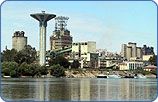 |
Industry (including energy generation) and mining represents, after services, a major economic sector throughout the region and its participation in GDP varies from 31% (Slovakia) to 42 % (Romania). Very similar is participation of this sector in the total structure of employment, from 29% (Austria) to 50% (Bulgaria). Nevertheless, there are quite important differences between upper, middle and lower Danube (UD, MD, LD) countries in connection with the sector itself and its impact on environment as a whole i.e. to water pollution. The importance of the sector from an environmental point of view is evident from the following facts: the total volume of abstracted water from Danube River System is currently 12,7-billion m3/ year; for cooling purposes an additional 15, 4 billion m3/year are abstracted. Out of the first figure, 62% is abstracted for industrial and mining purposes (not including cooling water for power purposes). Economic strength is in direct relation with industrial capacities and its performance and outputs. Moving from the upper towards the lower Danube countries, there are visible differences organized in a pattern between the EU member countries, the accession countries, and lastly, the transition countries. This pattern is also visible in the socio-economic and environmental relations. Better economic results are accompanied by better environmental performances. Since the beginning of the nineties, with the socio-economic changes in the whole CEE region and the shift from centrally to market-oriented economies, this sector has been passing through systematic reforms, including structural changes, privatization reform, foreign investment etc. After the initial problems that resulted in a great decline in production, some of these countries have been improving their industrial output, which has combined with legal, institutional and market developments to make a positive impact on the solution of major environmental problems. The main activities in this sector contributing to water pollution are to a great extent shared by the whole region, with the exception of the two upper Danube countries. There is a long list of activities contributing to water pollution, such as: obsolete industrial and mining technologies producing large amounts of liquid and solid waste; inadequate treatment of industrial solid and liquid waste; discharge of industrial wastewater into municipal sewers without any or adequate treatment; inadequate closure of industrial sites and plants; improper management of industrial hazardous waste; inefficient operation of industrial cooling systems; construction and operation of big dams and hydropower systems, etc. The major polluting industries are: ore mining activities; chemical and petrochemical industries; pulp and paper; metal works and machinery; food industry and textile industry. In view of the significant damage done to the natural environment, the governments of the Danube basin are committed to a development policy that integrates environmental considerations. All the DRB countries actually have a more or less comprehensive system of environmental and water sector policies and strategies, which usually reflects:
In this context, all the countries have developed a hierarchic system of medium and long-term objectives and principles that usually reflect the key environmental problems and the sector priorities on the national and regional level. Industry and energy, together with transport and agriculture, are key sector “driving forces” that impact the environment. The industry and energy sectors are reasonably well covered by policies, but some areas still need attention (e.g. energy efficiency; renewable energy) particularly in the middle and lower Danube countries. |






